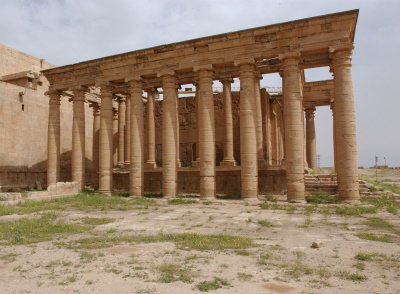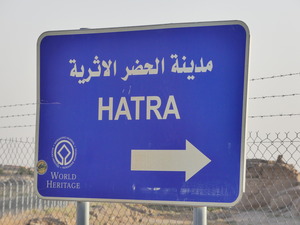Hatra

Hatra comprises the ruins of a fortified city that symbolizes Parthian power which for a long time threatened that of Rome.
The fortifications consist of a circular double wall, the best-preserved example of a design typical for the region. Hatra in the 1st and 2nd century AD was a major trade center with a population of mixed descent, resulting in the veneration of Greek, Syrian, Babylonian and Phoenician gods in its main sanctuary. This can still be seen in the inscriptions and statues of its temples.
Community Perspective: Hatra suffered damage from ISIS, but has undergone emergency restorations and has reopened to visitors. Thomas managed to enter in 2021 and found hardly any statues left, but the structures were mostly intact.
Map of Hatra
Community Reviews
Els Slots

Hatra is one of the stars of the National Museum in Baghdad: it produced those funny statues of men with curly hair and a surprised expression, raising one hand as if to say “Hi!”. The ancient city, built by the Parthians, dates mostly from the 1st and 2nd centuries AD. With its columns and capitals, it clearly was inspired by the “global” architectural trends of Classical Antiquity.
The archaeological site of Hatra lies a bit of a drive from the main highway, in the desert. This area has seen a lot of fighting with ISIS and still Shia militias keep an eye on its “back” as it borders the desert, which eventually leads to Syria. Regular villages in the area have been abandoned. You will still see bullet holes and find wasted bullets on the ground, but the site has been patched up, including reinstating damaged sculptural figures and reliefs. These don’t have the quality of those that you find in museums (they look a bit weathered), but I guess that has always been the case in the site’s modern history and is not a result of the recent conflict.
We arrived about an hour before sunset, a bit late, and we had to skip the introduction by the site manager to make the best of our time on the ground. It would have been worth having it, though, as the site lacks any interpretation. The core of the fortified city consists of what is essentially a multicultural temple complex, with halls dedicated to a specific deity each. You can climb one of those via a set of stairs to reach the roof, from where you have a good overview of the site. The city was built on a circular plan and surrounded by a double wall.
Read more from Els Slots here.
Thomas Buechler

We visited Hatra in November 2021, and we were not sure up to the last minute if we were allowed in. There was no pre-arranged permit, and we just drove to the main gate, northwest of Telol al baj where the military commander is holding office. Our guide had the necessary connections in Baghdad, but this is the Middle East and you never know. The waiting time was spent with shisha and tea, almost 3 hours, and our passports were scanned and sent to the capital. Suddenly the tension was gone, all smiles in the faces, and we were given the permits. The check-points further on the road were also informed, and we could enter the premises of the archaeological site of Hatra. What a relief! The city was known as "Beit Elaha" (House of God) and became an important religious centre in the Parthian Empire that flourished between the 1st and 3rd Centuries AD. The Roman emperors Trajan and Septimius Severus were not successful to conquer the city. However, about 240 AD Hatra fell to Shapur I, the ruler of the Persian dynasty, and was destroyed for the first time. Just 7 years ago, we sadly had to witness another destruction, this time of religious extremists. ISIS has bulldozed and blown up this great archaeological site, using picks, sledgehammers and assault riffles, and there is hardly any statues left as we wandered through the ruins. Later on we discovered some limestone statues of king Sanatruq I (the first king of Hatra) in the Erbil Civilization Museum in Kurdistan, so luckily some statues are being kept in museums. However, most buildings and temples we have found intact, and there are plans to renovate the site with financial support of various governments, and institutions. We were not allowed to make photos in the inner parts of the Great Temple and were accompanied by the supervisor and some military personnel.
Adam Mastrianni
I was a Brigade Intelligence Officer for the 101st Airborne in 2003 and I did a site survey after the "ground war" was over. After coordinating with the caretaker and his family we set up tours for soldiers to view the site. We gave some donations to the family to help them with the tours. The goal was to do more than just guard the site but also to show our soldiers about the historical site. It really is a shame that ISIS has hurt not just the Iraqis but also the world with their destruction.
Mike Taylor
Hatra was a very impressive place. I was there in 2003 with the 101st airborne. There was a unit there securing the site from looters. The man who was the caretqaker there gave us a tour. I remember walking in to the city itself, the plaza was impressive, there was an arena fairly close to an altar to one of the gods I believe. The main building held the throne room, the court room and a temple. For me it was my first trip into something that old. I loved it.
Site Info
- Full Name
- Hatra
- Unesco ID
- 277
- Country
- Iraq
- Inscribed
-
1985 - In Danger
- Type
- Cultural
- Criteria
-
2 3 4 6
- Categories
- Archaeological site - Near Eastern
- Link
- By ID
Site History
2015 In Danger
Due to intentional destruction by ISIS
1985 Inscribed
1983 Deferred
Deferred as conditions under which recommendation made not yet fulfilled
Site Links
Unesco Website
In the News
Connections
The site has 18 connections
Art and Architecture
Constructions
Damaged
Geography
History
Individual People
Science and Technology
Timeline
Trivia
WHS Names
World Heritage Process
Visitors
21 Community Members have visited.
The Plaque
 (photo by Clyde)
(photo by Clyde)